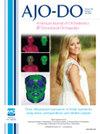Closed vs open surgical exposure of palatally displaced canines: Patients’ perceptions of recovery, operating time, and complications—A 2-center randomized controlled trial
IF 2.7
2区 医学
Q1 DENTISTRY, ORAL SURGERY & MEDICINE
American Journal of Orthodontics and Dentofacial Orthopedics
Pub Date : 2025-03-27
DOI:10.1016/j.ajodo.2024.11.014
引用次数: 0
Abstract
Introduction
The objective of this trial was to compare, in a 3-week follow-up, patients’ perceptions of recovery, surgery time, and complications related to surgical exposure of palatally displaced canines (PDCs) with either the closed or the open techniques.
Methods
This study was a 2-center, 2-arm parallel randomized clinical trial with a 1:1 allocation ratio. A total of 100 participants with PDC from 2 university clinics, aged <16 years, with unilateral or bilateral PDCs with cusp tip position in sectors II-IV, were randomly allocated to either closed-exposure or open-exposure techniques. Outcomes related to surgery and surgery/dressing removal interventions were analyzed by blinded assessors. Patients’ perceptions during both interventions and the week postinterventions were evaluated using take-home questionnaires, which included 3 question types: visual analog scale (VAS) questions about pain/discomfort, binary questions about analgesic intake, and open questions about complications. Surgical duration and professional-reported complications were assessed in patient journals. Mixed models with random intercepts were used to examine the effects of treatment on VAS scores (Gaussian model) and the use of analgesics (logistic model). Linear regression was used to examine the effect of the treatment on the operation. Statistical significance was set at <0.05.
Results
A total of 92 participants were included with no baseline differences between the intervention groups. There were no significant differences in patient perceptions between the centers. The open approach showed higher VAS scores for pain (coefficient, 8.58 [95% confidence interval, 2.29-14.88]; P <0.01) and discomfort (coefficient, 9.15 [95% confidence interval, 2.33-15.98]; P <0.01) from the exposure operation onwards, with nonsignificantly higher scores for patients with bilateral than unilateral PDCs. No pain/discomfort score differences were observed between treatment groups or between patients with bilateral or unilateral PDCs at surgery/dressing removal intervention. There were no differences in analgesic intake after surgery, but there was significantly more consumption after suture/dressing removal with the closed technique. Overall, a shorter duration was observed for the open technique, particularly when no flap surgeries were performed. Few complications were detected and were more common in the open group.
Conclusions
There was more pain and discomfort in the open group during surgery and the following week; however, no difference was observed during suture/dressing removal or the week after. There was increased analgesic intake in the closed group after suture dressing removal. Open surgical exposure required a shorter time, particularly when no flap surgery was performed. Complications were sparse and more common in the open group.
Registration
ClinicalTrials.gov (NCT05067712)
Protocol
Published before trial commencement.
Funding
University of Oslo.
上颚移位犬闭合与开放手术暴露:患者对恢复、手术时间和并发症的感知——一项双中心随机对照试验
本试验的目的是在为期3周的随访中,比较闭式或开放式腭移位犬(PDCs)手术暴露后患者对恢复、手术时间和并发症的感觉。方法采用2中心、2组随机对照临床试验,按1:1比例分配。来自两所大学诊所的100名年龄为16岁的PDC患者,患有单侧或双侧PDC,尖端位置在II-IV区,随机分配到封闭暴露或开放暴露技术。与手术和手术/脱敷料干预相关的结果由盲法评估者进行分析。使用带回家的问卷评估患者在干预期间和干预后一周的感知,问卷包括3个问题类型:视觉模拟量表(VAS)关于疼痛/不适的问题,关于止痛药摄入的二元问题,以及关于并发症的开放性问题。手术时间和专业报告的并发症在患者杂志上进行评估。采用随机截距混合模型检验治疗对VAS评分(高斯模型)和镇痛药使用(logistic模型)的影响。采用线性回归检验治疗对手术的影响。统计学意义为<;0.05。结果共纳入92名受试者,干预组间无基线差异。在两个中心之间,患者的认知没有显著差异。开放入路疼痛VAS评分较高(系数8.58[95%可信区间2.29-14.88];P <0.01)和不适(系数,9.15[95%可信区间,2.33-15.98];P <0.01),双侧前列腺癌患者的得分不显著高于单侧前列腺癌患者。在手术/脱敷料干预中,治疗组之间、双侧或单侧PDCs患者之间的疼痛/不适评分均无差异。术后镇痛药物用量无显著差异,但闭式拆解缝合/敷料后镇痛药物用量明显增加。总的来说,开放技术的持续时间较短,特别是当不进行皮瓣手术时。并发症很少,在开放组中更为常见。结论开放组术中及术后一周疼痛不适明显加重;然而,在缝线/敷料拆除期间或拆除后一周,没有观察到差异。缝合敷料拆除后,封闭组的镇痛剂量增加。开放手术暴露需要更短的时间,特别是在没有皮瓣手术的情况下。并发症在开放组中较少且更常见。registrationclinicaltrials .gov (NCT05067712)协议试验开始前公布。奥斯陆大学。
本文章由计算机程序翻译,如有差异,请以英文原文为准。
求助全文
约1分钟内获得全文
求助全文
来源期刊
CiteScore
4.80
自引率
13.30%
发文量
432
审稿时长
66 days
期刊介绍:
Published for more than 100 years, the American Journal of Orthodontics and Dentofacial Orthopedics remains the leading orthodontic resource. It is the official publication of the American Association of Orthodontists, its constituent societies, the American Board of Orthodontics, and the College of Diplomates of the American Board of Orthodontics. Each month its readers have access to original peer-reviewed articles that examine all phases of orthodontic treatment. Illustrated throughout, the publication includes tables, color photographs, and statistical data. Coverage includes successful diagnostic procedures, imaging techniques, bracket and archwire materials, extraction and impaction concerns, orthognathic surgery, TMJ disorders, removable appliances, and adult therapy.

 求助内容:
求助内容: 应助结果提醒方式:
应助结果提醒方式:


